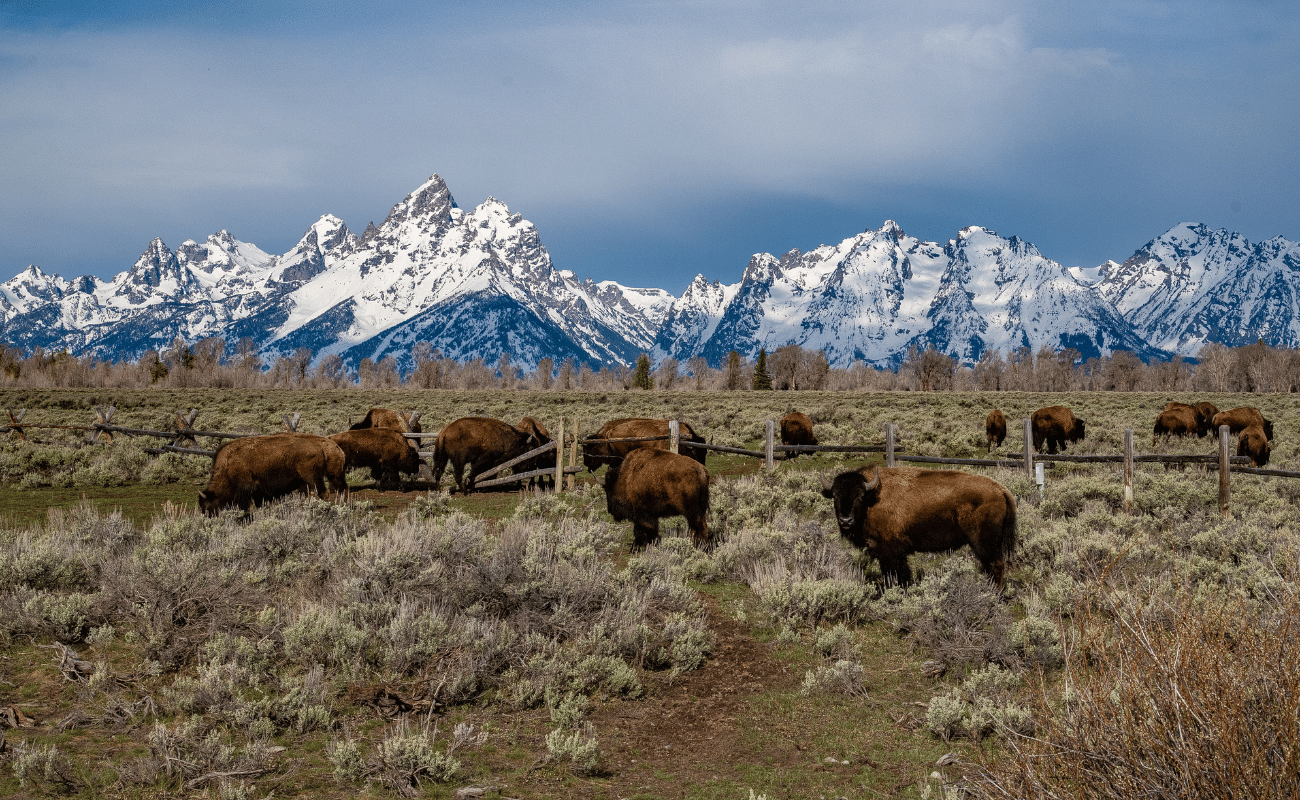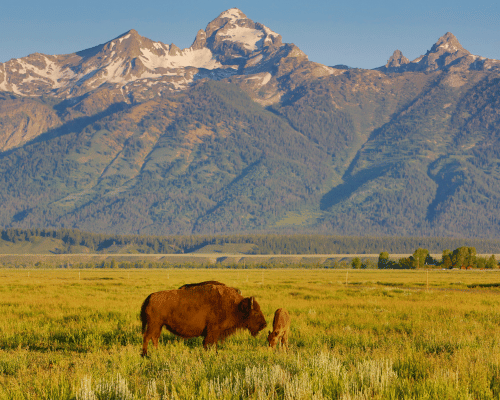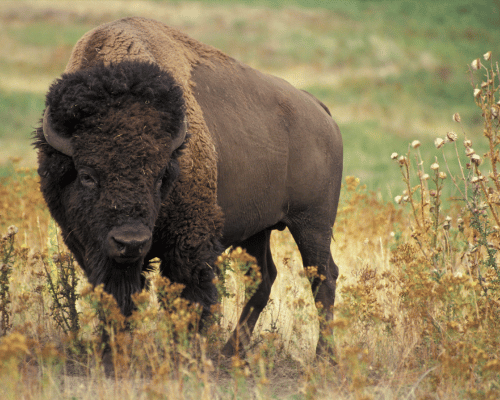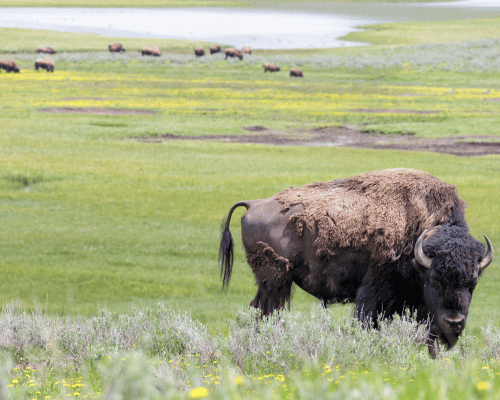Fun Facts About the Grand Teton Bison Herd

Welcome to Teton Wild Custom Wildlife Tours! We invite you to embark on an exciting journey through the fascinating world of the Grand Teton Bison Herd. As experts in the area, we are thrilled to share with you some intriguing facts about this majestic species and highlight its significance in the Grand Teton National Park.
The Grand Teton Bison Herd, also known as the Teton Herd, is a remarkable population of wild bison in America that roams the picturesque landscapes of the Grand Teton National Park. These iconic creatures have a rich history deeply intertwined with the park’s natural heritage.



Measures taken to protect and preserve the herd
Multiple measures have been implemented to protect and preserve the Grand Teton Bison Herd. Conservation initiatives involve collaboration between park authorities, wildlife experts, and local communities. Some key measures include:
The presence of the Grand Teton Bison Herd is of immense importance to the ecological balance and cultural heritage of the Grand Teton National Park. These magnificent animals serve as keystone species, playing a crucial role in shaping the park’s ecosystem. They contribute to the health of the grasslands, promote plant diversity through their grazing patterns, and provide a food source for other wildlife.
Moreover, bison have a deep cultural significance, particularly in Native American traditions. They are revered for their strength and resilience, symbolizing the connection between humans and nature. The Grand Teton Bison Herd serves as a living testament to the park’s rich history and the enduring bond between people and the wild.
Historical Background
We will take a step back in time and explore the origins and historical significance of the Grand Teton Bison Herd. Join us on this journey as we uncover the captivating stories that have shaped the presence of these majestic creatures in the Grand Teton National Park.
Origins and History of the Grand Teton Bison Herd
The Grand Teton Bison Herd traces its origins back to a time when vast herds of bison roamed freely across the American West. These magnificent animals have a deep-rooted history in the region, with evidence suggesting their presence for thousands of years. The pristine grasslands and diverse habitats of the Grand Teton National Park provided an ideal sanctuary for these iconic creatures.
However, like many bison herds, the Grand Teton Bison Herd faced a significant decline in numbers during the 19th century due to overhunting and habitat loss. It is through dedicated conservation efforts and the establishment of protected areas that the herd has managed to survive and thrive to this day.
Significance of bison in Native American culture and history
Bison hold a special place in the cultural and historical fabric of Native American communities. For countless generations, bison provided Native American tribes with sustenance, clothing, tools, and spiritual inspiration. The relationship between these tribes and the bison was one of deep reverence and harmony with nature.
Bison was not only a vital source of food and materials but also played a central role in religious ceremonies, storytelling, and tribal traditions. They symbolized strength, resilience, and the interconnectedness of all living beings. The Grand Teton Bison Herd serves as a testament to the enduring cultural legacy and the enduring bond between Native American peoples and the bison.
Characteristics and Behavior of Bison
We will dive into the captivating world of the Grand Teton Bison Herd and explore their unique characteristics and fascinating behaviors. Join us as we unravel the secrets of these majestic creatures that roam the Grand Teton National Park.
Physical characteristics of bison
The Grand Teton Bison Herd showcases an impressive array of physical characteristics that make them truly remarkable. These large mammals can weigh up to 2,000 pounds (900 kilograms) and stand about 6 feet (1.8 meters) tall at the shoulder. Both males and females boast a set of impressive horns, with those of the males being larger and more robust.
Their shaggy coats vary in color, ranging from dark brown to a reddish-brown hue. In winter, their coats become thicker, providing insulation against the harsh weather conditions of the park. These magnificent creatures possess a robust build and exhibit an unmistakable hump on their shoulders, giving them a powerful and formidable appearance.
Social structure and herd dynamics
Bison are highly social animals that form complex social structures within their herds. The Grand Teton Bison Herd consists of smaller groups called bands, which are comprised of females, their offspring, and young males. Older males, known as bulls, may form their own bachelor groups.
Within the herd, social interactions play a crucial role in maintaining order and hierarchy. Dominance is established through various displays of strength and posturing. Bulls compete for mating opportunities, engaging in impressive displays of power and aggression, including head-butting and wallowing in the dust.
Migratory patterns and seasonal behavior
The Grand Teton Bison Herd exhibits migratory patterns and seasonal behaviors influenced by the availability of food and weather conditions. During the warmer months, the bison graze on the lush grasslands and meadows of the park, moving to higher elevations as the seasons progress.
In the winter, bison employ a remarkable adaptation: they use their powerful heads to sweep away snow, revealing patches of grass underneath. This ability to forage in snow-covered landscapes allows them to survive in harsh winter conditions.
Conservation Efforts
We will delve into the critical topic of conservation and the efforts undertaken to protect and preserve the Grand Teton Bison Herd. Join us as we explore the significance of these endeavors and the role of the Grand Teton National Park in ensuring the long-term survival of these magnificent creatures.
Importance of Conservation for the Grand Teton Bison Herd
Conservation plays a vital role in safeguarding the Grand Teton Bison Herd and maintaining the delicate balance of the ecosystem they inhabit. Preserving the herd ensures the continuation of their important ecological role as a keystone species. By grazing on the grasslands, bison help regulate plant growth, promote biodiversity, and contribute to the overall health of the park’s ecosystem.
Additionally, the Grand Teton Bison Herd holds cultural and historical significance, serving as a living connection to the past and a symbol of the wild heritage of the region. Conservation efforts ensure that future generations can appreciate and learn from these majestic creatures, fostering a deeper understanding of our natural world.
Role of Grand Teton National Park in conservation efforts
Grand Teton National Park plays a crucial role in conservation efforts for the Grand Teton Bison Herd. The park’s management focuses on preserving the natural integrity of the ecosystem and ensuring the long-term survival of its wildlife, including the bison. The park collaborates with scientists, researchers, and conservation organizations to develop and implement effective strategies for protecting and managing the herd.
Through a combination of habitat preservation, wildlife management practices, and public engagement, Grand Teton National Park continues to serve as a steward of the Grand Teton Bison Herd, ensuring that future generations can experience the awe-inspiring beauty and ecological importance of these magnificent creatures.
Size and Population
We will explore the size and population dynamics of the Grand Teton Bison Herd. Join us as we delve into the current estimates, and factors influencing their growth or decline, and compare them with other buffalo in North America.
Current population estimates of the Grand Teton Bison Herd
The Grand Teton Bison Herd boasts a thriving population within the Grand Teton National Park. While population numbers can fluctuate, current estimates suggest that the herd consists of several hundred individuals. The specific number can vary due to factors such as birth rates, mortality rates, and migratory patterns.
It is important to note that population estimates are regularly monitored and updated through various research and conservation efforts. This information helps inform management decisions and ensure the long-term sustainability of the herd.
Factors influencing population growth or decline
Several factors can influence the growth or decline of the Grand Teton Bison Herd:
Comparison with other bison herds in the United States
While the Grand Teton Bison Herd is a notable population, it is important to consider its size and dynamics in comparison to other bison herds in the United States. Bison populations vary across different regions, and each herd has its unique characteristics.
For example, some herds, such as the Yellowstone Bison Herd in Yellowstone National Park, can comprise several thousand individuals, making them larger in size compared to the Grand Teton Bison Herd. However, it is crucial to remember that the size of a population does not solely determine its ecological or conservation significance.
Habitat and Range
We will explore the habitat and range of the Grand Teton Bison Herd. Join us as we venture into the breathtaking landscapes that these majestic creatures call home and discover the environmental factors that influence their habitat.
Description of the preferred habitat of bison
Bison have specific habitat preferences that contribute to their survival and well-being. They thrive in open grasslands, meadows, and prairies, where they can find an abundance of nutritious grasses and other vegetation. These areas provide the ideal forage for the bison’s grazing needs.
Furthermore, bison also require access to freshwater sources, such as rivers, streams, and ponds, to quench their thirst and fulfill their hydration needs. The availability of these water sources within their preferred habitat is crucial for their survival.
Range and distribution of the Grand Teton Bison Herd
The Grand Teton Bison Herd roams within the boundaries of the magnificent Grand Teton National Park, which spans over 300,000 acres of pristine wilderness. The herd’s range encompasses various habitats, including expansive grasslands, sagebrush flats, and meandering rivers.
While they primarily inhabit the lower elevations of the park, particularly the valley, Jackson Hole bison movements can be influenced by seasonal changes and resource availability. During the warmer months, the herd can be found grazing in the lower valleys, while in winter, they may migrate to higher elevations in search of forage and areas with less snow cover.
Environmental factors affecting the herd’s habitat
The habitat of the Grand Teton Bison Herd is influenced by a range of environmental factors, which shape their distribution and behavior. These factors include:
Feeding Habits
We will delve into the fascinating feeding habits of the Grand Teton Bison Herd. Join us as we uncover their dietary preferences, preferred forage, and explore their feeding behavior and grazing patterns.
Bison’s diet and preferred forage
The Grand Teton Bison Herd is herbivorous, meaning their diet consists entirely of plant material. Bison are highly adaptable grazers and can consume a variety of vegetation to meet their nutritional needs. Their preferred forage includes:
Feeding behavior and grazing patterns
The Grand Teton Bison Herd exhibits specific feeding behavior and grazing patterns that contribute to their survival and the health of the ecosystem. Some key aspects of their feeding habits include:
Understanding the feeding habits and grazing patterns of the Grand Teton Bison Herd offers valuable insights into their ecological role and highlights their impact on the vegetation dynamics of the park.
Breeding and Reproduction
We will explore the fascinating world of breeding and reproduction in the Grand Teton Bison Herd. Join us as we uncover the remarkable mating rituals, the gestation period, the birth of bison calves, and the parental care provided to the young.
Mating rituals and courtship behaviors
Mating rituals and courtship behaviors play a crucial role in the breeding process of the Grand Teton Bison Herd. During the breeding season, which typically occurs in late summer or early fall, male bison, known as bulls, engage in fierce competition for the attention of females, or cows.
Bulls showcase their dominance through elaborate displays of strength and aggression. They engage in activities such as wallowing, roaring, and vigorous sparring with other males. These displays serve to establish hierarchies and impress the females.
Once a female shows interest, courtship behaviors intensify. The bull will closely follow the female, emit distinctive vocalizations, and engage in nuzzling and rubbing against her. The courtship ritual often culminates in the bull mounting the female to initiate mating.
Gestation period and the birth of bison calves
After successful mating, the female bison, or cow, undergoes a gestation period of approximately 9 months. This period is similar to that of domestic cattle. During gestation, the cow seeks seclusion and safety away from the main herd.
In the spring, typically from April to May, the cow gives birth to a single calf. The birthing process is relatively quick and usually occurs without intervention. The newborn calf, known as a red dog for its reddish-brown color, weighs around 30-70 pounds (14-32 kilograms) at birth.
Parental care and nurturing of the young
Parental care is a crucial aspect of the Grand Teton Bison Herd’s reproductive cycle. After birth, the cow immediately begins bonding with her calf. She provides nourishment through nursing, and the calf relies solely on its mother’s milk for the first few months.
Cows are fiercely protective of their young and will defend them from potential threats. Calves stay close to their mothers, forming a strong bond. However, they also interact and play with other calves within the herd, fostering socialization and learning important behaviors.
As the calf grows, it gradually transitions to grazing on vegetation, supplementing its diet with milk. The cow continues to provide parental care and guidance until the calf reaches independence, which occurs at around one year of age.
Understanding the breeding and reproductive behaviors of the Grand Teton Bison Herd provides insight into the dynamics of the herd and highlights the importance of parental care in ensuring the survival and growth of the population.
Interactions with Other Wildlife
We will explore the intriguing interactions between the Grand Teton Bison Herd and other wildlife species within the ecosystem. Join us as we uncover the relationships, both mutualistic and competitive, that exist between the bison and the diverse array of wildlife in the Grand Teton National Park.
Relationship between bison and other species in the Grand Teton ecosystem
The Grand Teton Bison Herd coexists with a rich variety of wildlife species, each occupying its unique ecological niche within the ecosystem. Some of the notable relationships between bison and other species include:
Mutualistic or competitive interactions with other wildlife
Interactions between bison and other wildlife species can be both mutualistic and competitive, depending on the circumstances and resource availability. Some examples include:
It is through these intricate interactions that the Grand Teton Bison Herd contributes to the overall ecological dynamics of the park, shaping the vegetation, supporting scavengers, and influencing the distribution of other herbivores.
Role in Ecosystem
We will explore the important role played by the Grand Teton Bison Herd as a keystone species within the ecosystem. Join us as we uncover their impact on the structure of the ecosystem and the preservation of biodiversity.
Keystone species and its impact on the ecosystem
The Grand Teton Bison Herd holds a significant position as a keystone species within the Grand Teton National Park ecosystem. A keystone species is one that has a disproportionately large effect on its environment relative to its abundance. The presence and activities of bison have far-reaching impacts on the ecosystem, influencing various aspects of its structure and function.
Bison play a critical role in shaping the landscape through their grazing behavior. By selectively feeding on certain plant species, they influence the composition and structure of the vegetation. This has cascading effects on other organisms, as changes in plant communities can affect the availability of food and habitat for other herbivores, insects, and birds.
Furthermore, the wallowing behavior of bison creates depressions in the soil, contributing to the creation of microhabitats that are utilized by various organisms. These wallows can serve as breeding sites for amphibians, provide watering holes for birds and small mammals, and offer areas for seed germination.
Influence on vegetation and biodiversity
The presence of the Grand Teton Bison Herd promotes biodiversity and supports the overall health of the ecosystem. Their grazing patterns help maintain the balance between plant species, preventing dominance by certain plants and promoting the growth of diverse vegetation. This, in turn, enhances habitat diversity and provides niches for a wide range of wildlife species.
By creating openings in the grasslands and influencing the vegetation structure, bison facilitate the growth of new plants and the regeneration of grasses. This process promotes habitat heterogeneity, which benefits a variety of species, including insects, small mammals, and birds.
The Grand Teton Bison Herd’s impact extends beyond vegetation. As a keystone species, their activities influence nutrient cycling, seed dispersal, and soil health. They also provide a source of food and habitat for scavengers and decomposers, supporting the intricate web of life within the ecosystem.
Understanding the pivotal role of the Grand Teton Bison Herd in the ecosystem’s dynamics allows us to appreciate its significance and the importance of its conservation.
Cultural and Economic Significance
We will explore the cultural and economic significance of the Grand Teton Bison Herd. Join us as we uncover the deep-rooted cultural importance of bison in Native American traditions and the economic benefits and tourism opportunities associated with these magnificent creatures.
The cultural importance of bison in Native American traditions
Bison hold immense cultural importance in the traditions and histories of Native American tribes. For centuries, bison have been a source of sustenance, clothing, tools, and spiritual inspiration for these indigenous communities. The relationship between Native Americans and bison is steeped in reverence, respect, and a profound connection to the natural world.
Bison represent strength, resilience, and abundance. They symbolize the interconnectedness of all living beings and the balance between humans and nature. The Grand Teton Bison Herd serves as a living reminder of this cultural heritage, preserving the traditions and teachings passed down through generations.
Economic benefits and tourism opportunities related to the Grand Teton Bison Herd
The Grand Teton Bison Herd also offers significant economic benefits and tourism opportunities. The presence of these magnificent creatures attracts visitors from around the world who are eager to witness their beauty and experience the grandeur of the Grand Teton National Park.
The tourism industry surrounding the bison herd contributes to the local economy through various means, including guided wildlife tours, photography workshops, educational programs, and accommodation services. Visitors have the opportunity to witness the bison in their natural habitat, gaining a deeper appreciation for the wildlife and the conservation efforts dedicated to their preservation.
Moreover, the tourism industry supports local communities by creating employment opportunities and fostering cultural exchange. It allows visitors to learn about the history, cultural significance, and ecological importance of the bison, promoting a greater understanding and appreciation for the natural world.
The Grand Teton Bison Herd serves as a valuable asset, both culturally and economically, creating a unique and unforgettable experience for visitors while contributing to the conservation and sustainable development of the region.
Wildlife Viewing and Photography Tips
We will provide you with valuable tips and insights for wildlife viewing and photography of the Grand Teton Bison Herd. Join us as we uncover the best locations and times for observing the herd, safety guidelines for responsible wildlife viewing, and photography tips to capture memorable images.
Best locations and times for observing the Grand Teton Bison Herd
To increase your chances of observing the Grand Teton Bison Herd, consider visiting the following locations within the Grand Teton National Park:
It’s important to note that bison are wild animals, and their movements can be unpredictable. It’s best to check with park rangers or knowledgeable guides for up-to-date information on recent sightings and hotspots.
Safety guidelines and responsible wildlife viewing practices
When observing the Grand Teton Bison Herd, it is crucial to prioritize safety and respect for the animals and their environment. Follow these safety guidelines and responsible wildlife viewing practices:
Photography tips for capturing memorable images of the herd
To capture memorable images of the Grand Teton Bison Herd, consider the following photography tips:
Remember, wildlife photography should prioritize the welfare of the animals and their natural behavior. Respect their space, observe without disturbance, and enjoy the privilege of capturing moments of these majestic creatures in their natural habitat.
Conclusion
The Grand Teton Bison Herd holds a special place in the heart of the Grand Teton National Park. Their presence connects us to the rich history, cultural heritage, and the delicate balance of the natural world.
These remarkable creatures showcase awe-inspiring physical characteristics, exhibit complex social dynamics, and play a vital role in shaping the ecosystem. Through conservation efforts and responsible wildlife viewing practices, we can ensure the preservation of this iconic species for generations to come.
Let us continue to appreciate and celebrate the unique and fascinating qualities of the Grand Teton Bison Herd, cherishing their cultural, ecological, and economic significance. Together, we can contribute to the continued protection and conservation of these majestic creatures and the irreplaceable wilderness they call home.
Thank you for joining us on this adventure, and we hope to see you soon on a Teton Wild Custom Wildlife Tour, where you can experience the wonder of the Grand Teton Bison Herd firsthand.




